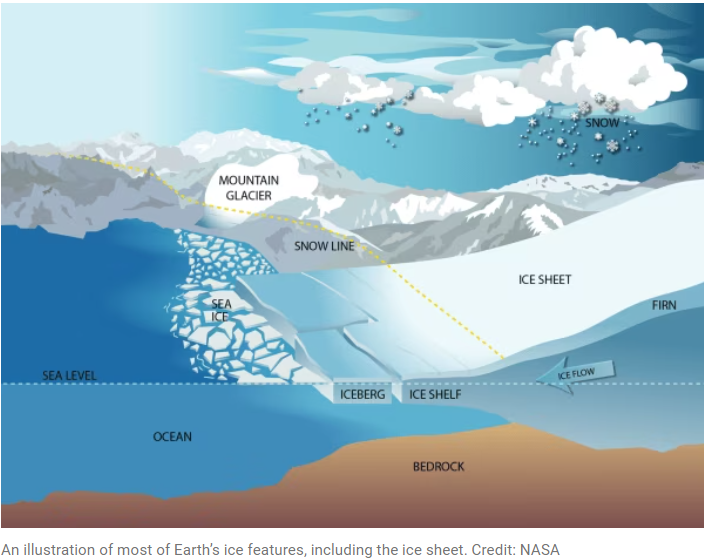ForumIAS announcing GS Foundation Program for UPSC CSE 2025-26 from 19 April. Click Here for more information.
Contents
| For 7PM Editorial Archives click HERE → |
Introduction
According to a recent study, the melting of the ice sheet in Western Antarctica is unavoidable, no matter how much carbon emissions are cut. The ice sheet melting would result in global mean sea level rise of 5.3 metres or 17.4 feet. This would have a potentially devastating consequence for millions of people living in vulnerable coastal cities across the world, including in India.
What is Ice Sheet, ice shelf and sea ice?
Ice Sheet- An ice sheet is a mass of glacial ice. The ice sheet covers more than 50,000 square kilometres of land. There are two major ice sheets in the world today-Greenland ice sheet and Antarctica ice sheet. Together, they contain about two-thirds of all the freshwater on Earth.
Ice sheets are different from sea ice- Sea ice is created by freezing of sea water. Sea ice is free-floating ice that surrounds the polar regions. Ice sheet, on the other hand, is the large glacial ice mass. The outermost edge of the ice sheet, known as ice shelf, floats on the ocean.
The following diagram depicts the ice sheet, ice shelf and sea ice-

According to a report by the National Aeronautics and Space Administration (NASA)- When ice sheets gain mass, they contribute to a fall in global mean sea level, and when they lose mass, they contribute to a rise in global mean sea level.
What is the reason behind the Antarctic ice sheet melting?
1. Erosion of the ice shelves by warming of the Amundsen sea- Ice shelves stabilise the land-based glaciers just behind them. The Amundsen sea located in Western Antarctica has been continuously warming since the last century.
The warm ocean water has been eroding the ice shelves. As these ice shelves are getting eroded, the ice sheet melting behind them has accelerated. This has been releasing more ice into the ocean, consequently causing sea level rise.

2. Global Warming-The Climate change which has resulted in increase of the global oceanic temperature has further accelerated the process of Antarctic ice loss.
| Read More- Reasons behind Global Warming |
What are the consequences of the ice sheet melting?
1. Sea Level Rise- The melting of Greenland and Antarctic ice sheets are the largest contributors of global sea level rise. According to WWF report- The Greenland ice sheet melting contributes to 20% of current sea level rise.
2. Increase in Coastal erosion and storms- The rising sea levels lead to coastal erosion like receding beach area of Maldives. The warming of air and ocean temperatures, create more frequent and intense coastal storm surges like hurricanes and typhoons.
3. Change in global oceanic circulation- The ice sheet melting in Antarctic and Greenland is changing the oceanic circulation of the Atlantic Ocean like the weakening of Atlantic Meridional Overturning Current(AMOC).
| Read More- Atlantic Meridional Overturning Current(AMOC) |
4. Effect on coastal wildlife- With the melting of ice sheets, wildlife like walrus are losing their home and polar bears are spending more time on land. This has resulted in higher rates of conflict between people and bears.
5. Increased vulnerability of Coastal Regions, including India- Coastal communities face risk of displacement and becoming climate refugees as their lives and livelihoods get threatened due to sea level rise. For Ex- The collapse of fisheries in the Gulf of Maine.
| Initiatives related to protection to Antarctic ice sheet 1. Antarctic Treaty- It has been signed to help safeguard the Antarctic environment and provide a framework for addressing the challenges arising from the threats of ice sheet melting. 2. Convention on the Conservation of Antarctic Marine Living Resources- To protect the wildlife and environmental resources of Antarctica. 3. Research and monitoring stations- India’s research stations at Antarctica like Maitri and Bharati to observe the changes in Antarctic environment. |
What should be the way forward to stop the melting and the sea level rise?
We have reached the point where some impacts of climate change can no longer be avoided, and substantial ice loss in West Antarctica is probably one of them. However, we must take the following measures to stop further melting of ice sheets.
1. Strict adherence to the Antarctic Treaty and Paris Agreement- We must strictly adhere to these treaties to preserve the continent’s unique environment and ecosystems. This involves regulating human activities, waste management and minimizing the environmental footprint.
2. Protect the loss of the East Antarctic Ice Sheet- We must take adequate steps to stop further loss of ice sheets in other parts of Antarctic like the east Antarctic.
3. Use of Geoengineering Techniques- Geoengineering techniques like the solar radiation management must be applied to slow down the ice sheet melting.
| Read More- The Indian Express UPSC Syllabus- GS 1-geographical features and their location-changes in critical geographical features (including water-bodies and ice-caps) and in flora and fauna and the effects of such changes. GS 3- Conservation, Environmental Pollution and Degradation, Environmental Impact Assessment |




